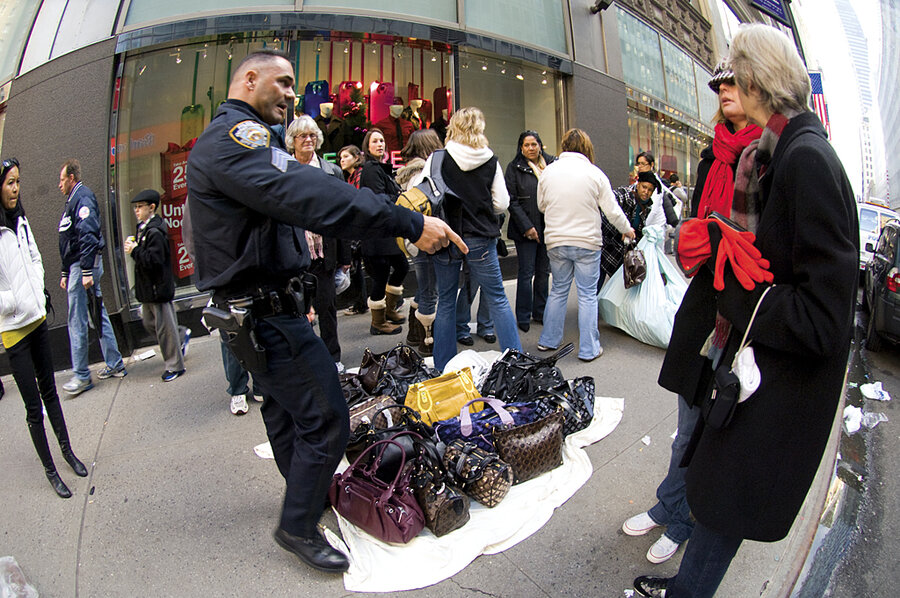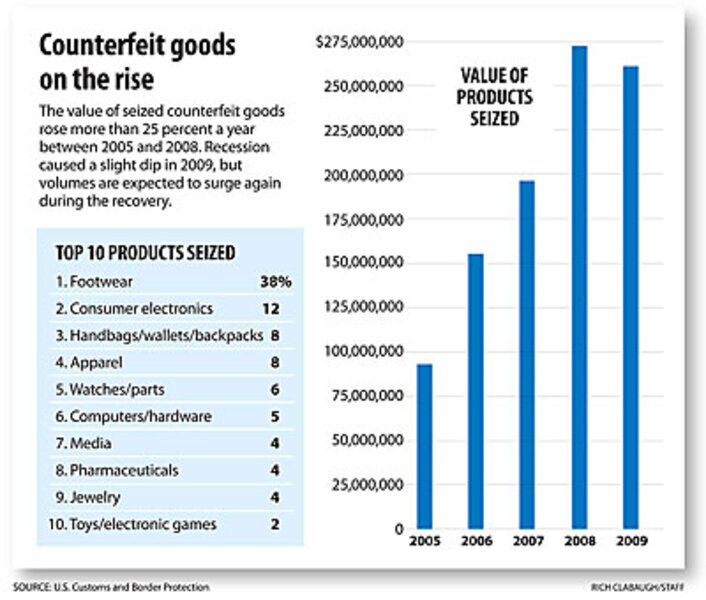Counterfeit goods: designer handbags, Rolex watches, and now airplane engine parts
Loading...
A sidewalk vendor. A wink. A misspelled designer logo glued to the interior of a handbag. The clues to counterfeit goods used to be so obvious that most Americans knew what they were buying.
No longer. By selling online, counterfeiters are hawking a growing variety of goods to a wider and unwitting audience. It's not just scarves and suitcases they're selling. It's electrical components, pharmaceuticals, even airplane parts, which find their way into legitimate channels.
Now that almost everything can be faked, counterfeiting is as much a consumer health and safety issue as an economic one. The toughest part for consumers: spotting the fakes.
"Rather than visiting a familiar and trusted corner store for every purchase, consumers have turned to the convenience of the Internet – and can't necessarily make informed judgments about the seller on the other end of the transaction," says Susan Scafidi, a law professor at Fordham University who has a website on fashion law, CounterfeitChic.com. "The shopper who would never have considered buying from the guy on the corner whispering, 'Pssst! Want to buy a watch?' can easily be fooled by a website that looks genuine but isn't."
The most common complaint about counterfeiting is its economic damage, especially for big firms selling overseas. It devalues brands and causes the loss of about 750,000 American jobs, says the US Chamber of Commerce. Now health and safety concerns are coming to the fore.
For example: Fake electrical components (which can end up malfunctioning while doing important tasks) cost the technology sector an estimated $100 billion a year, according to the National Electronic Distributors Association. Most alarming is the rise in counterfeit pharmaceuticals.
"As late as 2004, pharmaceuticals weren't even on the list," says Richard Halverson, of the National Intellectual Property Rights Coordination Center, which coordinates the US government's enforcement of intellectual property rights (IPR). "Now they're making the Top 10 list of items being seized."
The problem can hardly be understated, says a Department of Commerce official, herself a recent victim of counterfeiting when she purchased DVDs of a television series from eBay. At least 115 people, many of them children, were poisoned by a counterfeit cough medicine in Panama in 2007. The worst confirmed airline accident caused by fake airplane parts occurred in 1989, when a charter company's turboprop plane flying 55 passengers from Oslo to Hamburg, Germany, crashed into the North Sea. There were no survivors.
"We have enforcement agencies that keep those products out of the hands of consumers in the United States," says the Commerce Department official, who asked that her name not be used. "But it's not out of the realm of possibility that something could get through."
Counterfeiting goods is one of the fastest growing crimes in the US. The total value of IPR seizures rose more than 25 percent a year between 2005 and 2008, according to US Customs and Border Protection. Last year, because of the recession, IPR seizures and the value of the seizures dropped slightly: 1 percent and 4 percent, respectively. Still, there were 14,841 IPR seizures in 2009 with a domestic value of $260.7 million. And in the context of an overall 25 percent drop in US imports, "really, we equate that [slight dip] to an increase," Mr. Halverson says.
Counterfeiting is expected to start growing again as the economy recovers.
To protect yourself against inadvertently buying a fake, remember that if the price is too good to be true, it probably is. Buy only from sellers with an established reputation. When buying online, only use retailers that have a functioning phone number for customer service, a coherent return policy, and a physical address.
Professor Scafidi adds this caution: "Be suspicious of retailers with a full stock of otherwise sold-out items, like the latest 'it' fashion or popular children's toy."
Some fakes are still easy to spot because the quality is inferior or there are obvious errors, like spelling mistakes on labels. Some might require closer scrutiny. Examine merchandise carefully, including the packaging and labeling. Something as simple as a different font size on a drug label or a logo missing on a bluejean's rivets can indicate a fake. If you still aren't sure, take your product to a store that sells the actual product and compare your merchandise side by side.






